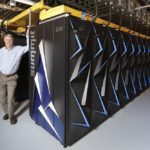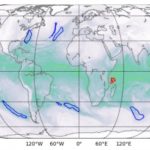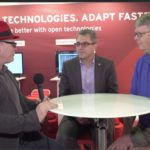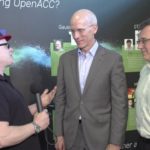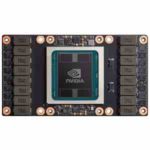Jack Wells from ORNL gave this talk at the GPU Technology Conference. “HPC centers have been traditionally configured for simulation workloads, but deep learning has been increasingly applied alongside simulation on scientific datasets. These frameworks do not always fit well with job schedulers, large parallel file systems, and MPI backends. We’ll share benchmarks between native compiled versus containers on Power systems, like Summit, as well as best practices for deploying learning and models on HPC resources on scientific workflows.”
Interview: Why HPC is the Right Tool for Physics
Over at the SC19 Blog, Charity Plata continues the HPC is Now series of interviews with Enrico Rinaldi, a physicist and special postdoctoral fellow with the Riken BNL Research Center. This month, Rinaldi discusses why HPC is the right tool for physics and shares the best formula for garnering a Gordon Bell Award nomination. “Sierra and Summit are incredible machines, and we were lucky to be among the first teams to use them to produce new scientific results. The impact on my lattice QCD research was tremendous, as demonstrated by the Gordon Bell paper submission.”
Looking Back at SC18 and the Road Ahead to Exascale
In this special guest feature from Scientific Computing World, Robert Roe reports on new technology and 30 years of the US supercomputing conference at SC18 in Dallas. “From our volunteers to our exhibitors to our students and attendees – SC18 was inspirational,” said SC18 general chair Ralph McEldowney. “Whether it was in technical sessions or on the exhibit floor, SC18 inspired people with the best in research, technology, and information sharing.”
New TOP500 List topped by DOE Supercomputers
The latest TOP500 list of the world’s fastest supercomputers is out, a remarkable ranking that shows five Department of Energy supercomputers in the top 10, with the first two captured by Summit at Oak Ridge and Sierra at Livermore. With the number one and number two systems on the planet, the “Rebel Alliance” vendors of IBM, Mellanox, and NVIDIA stand far and tall above the others.
Summit Supercomputer Breaks Exaop Barrier on Neural Net Trained to Recognize Extreme Weather Patterns
“Using a climate dataset from Berkeley Lab on the Summit supercomputer at Oak Ridge, they trained a deep neural network to identify extreme weather patterns from high-resolution climate simulations. By tapping into the specialized NVIDIA Tensor Cores built into the GPUs at scale, the researchers achieved a peak performance of 1.13 exaops and a sustained performance of 0.999 – the fastest deep learning algorithm reported to date and an achievement that earned them a spot on this year’s list of finalists for the Gordon Bell Prize.”
Podcast: From Here to Ai with Jack Wells from Oak Ridge
In this Conversations with Dez podcast, Dez Blanchfield sits down with Jack Wells from ORNL to talk about about his personal & professional life journey, his role at Oak Ridge National Lab, how Artificial Intelligence is being deployed & leveraged in HPC, and the role IBM’s POWER9 solution is playing in supporting Oak Ridge and its mission. Jack Wells is the Director of Science for the Oak Ridge Leadership Computing Facility.
How Red Hat Powers the #1 Summit Supercomputer
In this video from ISC 2018, Yan Fisher from Red Hat and Buddy Bland from ORNL discuss Summit, the world’s fastest supercomputer. Red Hat teamed with IBM, Mellanox, and NVIDIA to provide users with a new level of performance for HPC and AI workloads. ”
But the rapid innovation showcased by Summit must be consumable, and that’s where Red Hat Enterprise Linux comes in. Despite the scale, processing capability, and “intelligence” of Summit’s composition, end users interact with something they understand: Linux, in the form of the world’s leading enterprise Linux platform. Red Hat Enterprise Linux provides a common, stable basis that ties together all of this innovation.”
InfiniBand Powers World’s Fastest Supercomputer
Today the InfiniBand Trade Association (IBTA) announced that the latest TOP500 List results that report the world’s new fastest supercomputer, Oak Ridge National Laboratory’s Summit system, is accelerated by InfiniBand EDR. InfiniBand now powers the top three and four of the top five systems. The latest rankings underscore InfiniBand’s continued position as the interconnect of choice for the industry’s most demanding high performance computing (HPC) platforms. “As the makeup of the world’s fastest supercomputers evolve to include more non-HPC systems such as cloud and hyperscale, the IBTA remains confident in the InfiniBand Architecture’s flexibility to support the increasing variety of demanding deployments,” said Bill Lee, IBTA Marketing Working Group Co-Chair. “As evident in the latest TOP500 List, the reinforced position of InfiniBand among the most powerful HPC systems and growing prominence of RoCE-capable non-HPC platforms demonstrate the technology’s unparalleled performance capabilities across a diverse set of applications.”
OpenACC Helps Scientists Port their code at the Center for Application Readiness (CARR)
In this video, Jack Wells from the Oak Ridge Leadership Computing Facility and Duncan Poole from NVIDIA describe how OpenACC enabled them to port their codes to the new Summit supercomputer. “In preparation for next-generation supercomputer Summit, the Oak Ridge Leadership Computing Facility (OLCF) selected 13 partnership projects into its Center for Accelerated Application Readiness (CAAR) program. A collaborative effort of application development teams and staff from the OLCF Scientific Computing group, CAAR is focused on redesigning, porting, and optimizing application codes for Summit’s hybrid CPU–GPU architecture.”
NVIDIA Tensor Core GPUs Accelerate World’s Fastest Supercomputers
Today NVIDIA is highlighting news that the world’s top AI supercomputers on the TOP500 are all powered by the company’s Tensor Core GPUs. The new “AI supercomputers” on the list include Summit and Sierra in the USA and the ABCI machine in Japan. “The new TOP500 list clearly shows that GPUs are the path forward for supercomputing in an era when Moore’s Law has ended,” said Ian Buck, vice president and general manager of accelerated computing at NVIDIA.




